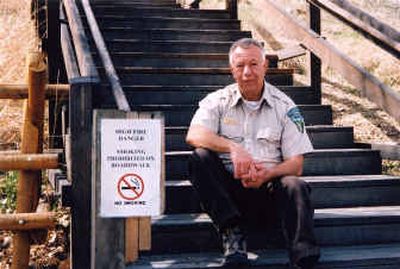BLM staff worry about fire danger

POMPEYS PILLAR NATIONAL MONUMENT, Mont. – Each year, some 50,000 tourists visit the jutting sandstone butte engraved by explorer William Clark and are warned by signs or guides of the fire danger in this part of drought-stricken Montana.
But this year, with thousands more expected here and at other stops along the Lewis and Clark trail, federal land managers are looking for creative, new ways to reach travelers, particularly those floating rivers, hiking backcountry trails or camping in areas where billboards can’t go up and radio coverage can be spotty.
Prevention plans are being drawn up for sites along the way, including the Missouri River Breaks in north-central Montana and Lolo Pass in the western part of the state. The Bureau of Land Management is planning to haul an interpretive trailer, with fold-out exhibits on fire danger and prevention, to bicentennial events across the region.
The hope, says BLM’s Mike Dannenberg, is to prevent human-caused fires along the trail blazed 200 years ago by Clark and Meriwether Lewis.
“Are we worried? You bet,” said Dannenberg, a fire education and mitigation specialist with the BLM in Billings. Many visitors won’t understand or have experience with wildfire, he said, and having more people on lands parched after years of drought only fuels the potential for accidental blazes from escaped campfires, carelessly tossed cigarettes or passing vehicles.
No sure thing
Tourism officials who, for years, have been preparing for Montana’s turn in the national spotlight, say the summer fire danger is still speculative. They worry that talk about a potentially explosive season could put a damper on visitor plans to follow the routes the explorers took on their trek to find the Pacific Ocean.
“If it rains through spring, then all our panic and talk about fires was for naught,” said Clint Blackwood, executive director of the Montana Lewis and Clark Bicentennial Commission.
Forecasts so far haven’t been rosy, particularly in the Northwest: Winter snowpack was at or near record lows in several states, and the federal Climate Prediction Center, in its seasonal drought outlook through June, calls for drought conditions to persist in western Montana, all of Idaho and parts of Oregon and Washington – states that have already suffered years of drought and through which the Lewis and Clark trail winds.
Dannenberg said land managers want to ensure as much public land as possible stays available – and unrestricted – to visitors along the 2,000-mile Lewis and Clark trail in Montana and that they will prepare for the fire season regardless of whether the region sees timely spring rains.
“I’m 99.9 percent sure we will have a fire this year,” he said, adding that officials need to find the balance between “crying wolf” and being caught flat-footed.
“The taxpayers are paying us to be prepared to protect public lands. And, along with that, comes the responsibility that we have to provide as much safety for the public as we can,” Dannenberg said.
Planning ahead
Federal, state and local officials from the Billings area – one of a handful of groups statewide that meet during the fire season to assess fire danger and discuss possible restrictions – planned to hold their first meeting this month, weeks ahead of usual, in anticipation of a possible active season, BLM spokeswoman Ann Boucher said.
Later this month, fire officials will begin work on prevention plans for what are expected to be the more popular areas along the trail, including Pompeys Pillar, the Breaks, Fort Benton, Three Forks and Lolo Pass, Dannenberg said. They will be asked to analyze their audiences – bikers, campers, hikers, boaters – and check convention at the door.
This summer, there could be Burma Shave-style signs or campsite talks or brochures handed out at parking lots or boat docks, he said.
“We want people to think outside the box,” he said. “What will really grab people?”
Tim Murphy, fire operations specialist with the interagency Northern Rockies Coordinating Group, said agencies will rely on interpretive staff – many of whom will already be involved in Lewis and Clark activities – to help spread the fire prevention message.
Margaret Gorski, the Forest Service’s Lewis and Clark bicentennial coordinator, said safety is the top priority and that land managers will work with tourism officials to minimize disruptions to visitors in the case of a fire or the need to impose smoking, campfire, travel or other restrictions.
“Tourism is important to Montana and Idaho, and we don’t want to impact tourism more than we need to,” she said.
Best estimates for Montana’s lone “signature” event this summer – a 34-day spectacle in Great Falls featuring such things as a ballet, re-enactments, fireworks and float trips – range from 50,000 to 150,000 visitors, and tourism officials expect more during the summer at small-town commemorations and popular sites along the trail, like Pompeys Pillar.
Part of the landscape here is still washed in winter browns, and swaths of shoreline lay exposed near the Yellowstone River, which flows behind the pillar.
But Pompeys Pillar monument manager Dick Kodeski said he isn’t worried much about the months ahead. He said Pompeys Pillar, a developed and controlled BLM recreation site, will be open to visitors regardless of the fire season.